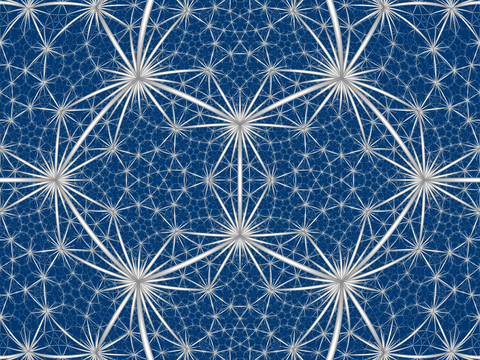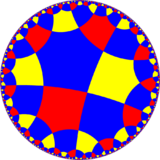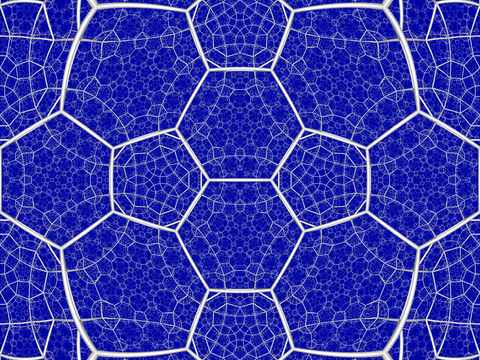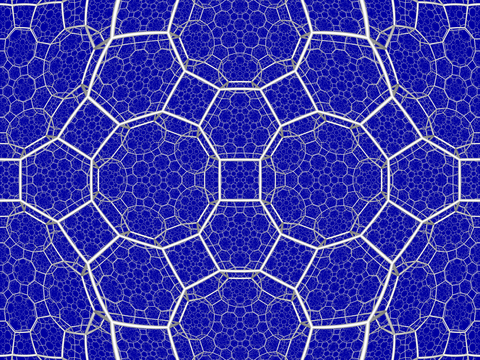Dodecahedral-icosahedral honeycomb
| Dodecahedral-icosahedral honeycomb | |
|---|---|
| Type | Compact uniform honeycomb |
| Schläfli symbol | {(3,5,3,5)} or {(5,3,5,3)} |
| Coxeter diagram | |
| Cells | {5,3} {3,5} 40px r{5,3} |
| Faces | triangle {3} pentagon {5} |
| Vertex figure | 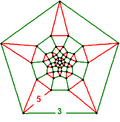 rhombicosidodecahedron |
| Coxeter group | [(5,3)[2]] |
| Properties | Vertex-transitive, edge-transitive |
In the geometry of hyperbolic 3-space, the dodecahedral-icosahedral honeycomb is a uniform honeycomb, constructed from dodecahedron, icosahedron, and icosidodecahedron cells, in a rhombicosidodecahedron vertex figure.
A geometric honeycomb is a space-filling of polyhedral or higher-dimensional cells, so that there are no gaps. It is an example of the more general mathematical tiling or tessellation in any number of dimensions.
Honeycombs are usually constructed in ordinary Euclidean ("flat") space, like the convex uniform honeycombs. They may also be constructed in non-Euclidean spaces, such as hyperbolic uniform honeycombs. Any finite uniform polytope can be projected to its circumsphere to form a uniform honeycomb in spherical space.
Images
Wide-angle perspective views:
Related honeycombs
There are 5 related uniform honeycombs generated within the same family, generated with 2 or more rings of the Coxeter group ![]()
![]()
![]()
![]()
![]() :
: ![]()
![]()
![]()
![]()
![]() ,
, ![]()
![]()
![]()
![]()
![]() ,
, ![]()
![]()
![]()
![]()
![]() ,
, ![]()
![]()
![]()
![]()
![]() ,
, ![]()
![]()
![]()
![]()
![]() .
.
Rectified dodecahedral-icosahedral honeycomb
| Rectified dodecahedral-icosahedral honeycomb | |
|---|---|
| Type | Compact uniform honeycomb |
| Schläfli symbol | r{(5,3,5,3)} |
| Coxeter diagrams | |
| Cells | r{5,3} rr{3,5} |
| Faces | triangle {3} square {4} pentagon {5} |
| Vertex figure |  cuboid |
| Coxeter group | (5,3)[2], |
| Properties | Vertex-transitive, edge-transitive |
The rectified dodecahedral-icosahedral honeycomb is a compact uniform honeycomb, constructed from icosidodecahedron and rhombicosidodecahedron cells, in a cuboid vertex figure. It has a Coxeter diagram ![]()
![]()
![]()
![]()
![]() .
.
- Perspective view from center of rhombicosidodecahedron
Cyclotruncated dodecahedral-icosahedral honeycomb
| Cyclotruncated dodecahedral-icosahedral honeycomb | |
|---|---|
| Type | Compact uniform honeycomb |
| Schläfli symbol | ct{(5,3,5,3)} |
| Coxeter diagrams | |
| Cells | t{5,3} {3,5} |
| Faces | triangle {3} decagon {10} |
| Vertex figure |  pentagonal antiprism |
| Coxeter group | (5,3)[2], |
| Properties | Vertex-transitive, edge-transitive |
The cyclotruncated dodecahedral-icosahedral honeycomb is a compact uniform honeycomb, constructed from truncated dodecahedron and icosahedron cells, in a pentagonal antiprism vertex figure. It has a Coxeter diagram ![]()
![]()
![]()
![]()
![]() .
.
- Perspective view from center of icosahedron
Cyclotruncated icosahedral-dodecahedral honeycomb
| Cyclotruncated icosahedral-dodecahedral honeycomb | |
|---|---|
| Type | Compact uniform honeycomb |
| Schläfli symbol | ct{(3,5,3,5)} |
| Coxeter diagrams | |
| Cells | {5,3} t{3,5} |
| Faces | pentagon {5} hexagon {6} |
| Vertex figure |  triangular antiprism |
| Coxeter group | (5,3)[2], |
| Properties | Vertex-transitive, edge-transitive |
The cyclotruncated icosahedral-dodecahedral honeycomb is a compact uniform honeycomb, constructed from dodecahedron and truncated icosahedron cells, in a triangular antiprism vertex figure. It has a Coxeter diagram ![]()
![]()
![]()
![]()
![]() .
.
- Perspective view from center of dodecahedron
It can be seen as somewhat analogous to the pentahexagonal tiling, which has pentagonal and hexagonal faces:
Truncated dodecahedral-icosahedral honeycomb
| Truncated dodecahedral-icosahedral honeycomb | |
|---|---|
| Type | Compact uniform honeycomb |
| Schläfli symbol | t{(5,3,5,3)} |
| Coxeter diagrams | |
| Cells | t{3,5} t{5,3} 40px rr{3,5} 40px tr{5,3} |
| Faces | triangle {3} square {4} pentagon {5} hexagon {6} decagon {10} |
| Vertex figure |  trapezoidal pyramid |
| Coxeter group | [(5,3)[2]] |
| Properties | Vertex-transitive |
The truncated dodecahedral-icosahedral honeycomb is a compact uniform honeycomb, constructed from truncated icosahedron, truncated dodecahedron, rhombicosidodecahedron, and truncated icosidodecahedron cells, in a trapezoidal pyramid vertex figure. It has a Coxeter diagram ![]()
![]()
![]()
![]()
![]() .
.
- Perspective view from center of truncated icosahedron
Omnitruncated dodecahedral-icosahedral honeycomb
| Omnitruncated dodecahedral-icosahedral honeycomb | |
|---|---|
| Type | Compact uniform honeycomb |
| Schläfli symbol | tr{(5,3,5,3)} |
| Coxeter diagrams | |
| Cells | tr{3,5} |
| Faces | square {4} hexagon {6} decagon {10} |
| Vertex figure |  Rhombic disphenoid |
| Coxeter group | [(2,2)+[(5,3)[2]]], |
| Properties | Vertex-transitive, edge-transitive, cell-transitive |
The omnitruncated dodecahedral-icosahedral honeycomb is a compact uniform honeycomb, constructed from truncated icosidodecahedron cells, in a rhombic disphenoid vertex figure. It has a Coxeter diagram ![]()
![]()
![]()
![]()
![]() .
.
- Perspective view from center of truncated icosidodecahedron
See also
- Convex uniform honeycombs in hyperbolic space
- List of regular polytopes
References
- Coxeter, Regular Polytopes, 3rd. ed., Dover Publications, 1973. ISBN 0-486-61480-8. (Tables I and II: Regular polytopes and honeycombs, pp. 294–296)
- Coxeter, The Beauty of Geometry: Twelve Essays, Dover Publications, 1999 ISBN 0-486-40919-8 (Chapter 10: Regular honeycombs in hyperbolic space, Summary tables II, III, IV, V, p212-213)
- Jeffrey R. Weeks The Shape of Space, 2nd edition ISBN 0-8247-0709-5 (Chapter 16-17: Geometries on Three-manifolds I, II)
- Norman Johnson Uniform Polytopes, Manuscript
- N.W. Johnson: The Theory of Uniform Polytopes and Honeycombs, Ph.D. Dissertation, University of Toronto, 1966
- N.W. Johnson: Geometries and Transformations, (2018) Chapter 13: Hyperbolic Coxeter groups
 |
